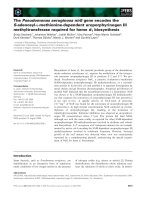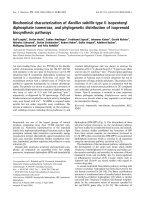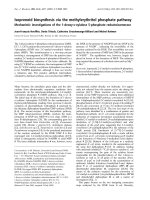Carbs biosynthesis
Bạn đang xem bản rút gọn của tài liệu. Xem và tải ngay bản đầy đủ của tài liệu tại đây (3.06 MB, 21 trang )
Carbohydrate Biosynthesis in Plants
1
Photosynthesis
2
Photosynthesis
• The light-independent reactions make sugars.
– take place in stroma
– needs carbon dioxide from atmosphere
– use energy to build a sugar in a cycle of chemical
reactions
3
Photosynthesis
• The equation for the overall process is:
6CO2 + 6H2O C6H12O6 + 6O2
granum (stack of thylakoids)
1s
un
li
chloroplast
gh
t
6H2O
thylakoid
6CO2
3
6O2
2
energy
stroma (fluid outside the thylakoids)
1 six-carbon sugar
4
C6H12O6
4
Photosynthesis
Left side: Light
Dependent Rxs
Right side: Light
Independent Rxs
5
Photosynthesis
Photosynthesis produces sugars that store chemical
energy.
Photosynthesis captures energy from sunlight to make
sugars.
Chlorophyll is a molecule that absorbs light energy.
In plants, chlorophyll found in chloroplasts.
chloroplast
leaf cell
leaf
6
Photosynthesis
Photosynthesis in plants occurs in chloroplasts.
• Photosynthesis takes place in two parts of chloroplasts.
– grana (thylakoids)
grana (thylakoids)
– stroma
chloroplast
stroma
7
Photosynthesis
• The light-dependent reactions capture energy from sunlight.
–
–
–
–
–
take place in thylakoids
water and sunlight are needed
chlorophyll absorbs energy
energy is transferred along thylakoid membrane for reactions
oxygen is released
8
Photosynthesis vs Cell Respiration
9
Photosynthesis: From Light and CO2 to
Glyceraldehyde 3-phosphate
• The photosynthesis of one
molecule of glyceraldehyde 3phosphate requires the
capture of roughly 24
photons
Synthesis of Glyceraldehyde-3 Phosphate
(First Stage)
• Three rounds of the
Calvin cycle fixes
three CO2
molecules and
produces one
molecule of 3phosphoglycerate
Stoichiometry of Carbon Assimilation
Overall Process:
3 CO2 + 9 ATP + 6 NADPH → glyceraldehyde 3-phosphate + 9 ADP + 6 NADP+ + 8 Pi
•
•
Assimilation of 3 carbons and 1
phosphorous per cycle
Inorganic phosphate must be
replaced for sustained ATP
synthesis in chloroplast
Stoichiometry and
Energetics
• Fixation of three
CO2 molecules
yields one
glyceraldehyde 3phosphate
• Nine ATP
molecules and six
NADPH molecules
are consumed
Rubisco (ribulose 1,5-bisphosphate carboxylase)
• Rubisco is a large Mg++-containing enzyme that makes a new
carbon-carbon bond using CO2 as a substrate
• Inefficient (kcat~ 3s-1)
• Ru1,5P2 + CO2 –> 2 3-phosphoglycerate (3PG)
Glyceraldehyde 3phosphate
• Converted to
starch in the
chloroplast
• Converted to
sucrose for
export
• Recycled to
ribulose 1,5bisphosphate
Starch and Sucrose Biosynthesis
• Excessive amounts of triose and monosaccharide
phosphates are converted to alternative forms in the light
• Liberates phosphate for ATP synthesis
Starch Biosynthesis
• Carbohydrate storage
• Occurs in plastids
• ADP-glucose substrate
• Adds to reducing end
(unlike glycogen synthesis)
• α(1→4) glucose (amylose)
with α(1→6) branches
(amylopectin)
Sucrose Biosynthesis
• Carbohydrate transport
• Occurs in cytoplasm
• Fructose 6-phosphate &
UDP-glucose
• Joins reducing (anomeric)
hydroxyls
• Glucose(α1↔β2)Fructose
Cellulose Biosynthesis
• Cell wall structure
• Occurs in cytoplasm and at plasma membrane
• Lipid-linked carrier and membrane protein
complex
• UDP-glucose is generated from sucrose and
UDP by sucrose synthase
• UDP-glucose is substrate for cellulose
synthase; adds glucose monomers to nonreducing end
• Cellulose is β(1→4) linked glucose
Glycolate Pathway
• Salvage of 2-phosphoglycolate
• Involves metabolite transport and
enzymes in chloroplast,
peroxisome and mitochondrion
• Glycine decarboxylase is key
enzyme
• Process consumes O2 and evolves
CO2 “Photorespiration”
• Wastes energy and fixed carbon
and nitrogen
Glyceraldehyde 3phosphate
• Converted to
starch in the
chloroplast
• Converted to
sucrose for
export
• Recycled to
ribulose 1,5bisphosphate









